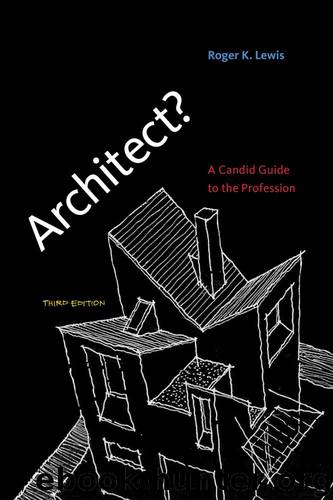Architect? by Roger K. Lewis

Author:Roger K. Lewis [Lewis, Roger K.]
Language: eng
Format: epub
ISBN: 9780262316606
Publisher: The MIT Press
Published: 2013-08-01T04:00:00+00:00
Reference Letters
All schools ask that you request teachers or others who know you and your work to send letters attesting to your character, skills, and academic qualifications. These letters can be very decisive but of little impact if they come from personal friends or relatives whose credentials or objectivity are doubtful. To make reference letters count, ask the writers to focus on your educational and professional achievements, your work habits, and your creative potential. The best letters are from employers and teachers who knew you well as a worker or student. Citation of specific accomplishments, abilities, and outstanding personal characteristics will be most helpful to admissions committees. Finally, it is always a good idea for the writer to explain briefly his or her relationship to you: where, when, and in what circumstances.
Grades
There is no way around it—grades are very important. Apply with the highest grade point average you can muster. However, grades are not everything, and softness in course grades can sometimes be overcome by strengths elsewhere, especially portfolios, letters of reference, and exam scores or experience. It is not unusual for architecture schools to admit students with less-than-stellar academic records but who show great potential through a combination of experience and creative talent exhibited in their portfolios. This is particularly true of applicants who have been out of school for a while.
Essays
A short essay or written statement, dreaded by some students, is often a component of many admission applications. Schools pose similar questions for you to address: why do you want to study architecture? Why this school? What experiences have you had that significantly affected you? I have read many such essays and statements and frankly most are of little value in assessing a prospective student’s qualifications and potential. Essays and statements often are neither insightful nor well written—too long, rambling, and repetitive. Consequently, your writing should demonstrate four things: that you have something relevant and interesting to say; that you can think and organize your thoughts logically; that you can express yourself clearly, succinctly, and perhaps poetically; and that you are able to write in English using reasonably correct grammar, spelling, and punctuation. What you say may be less important than how well you say it.
Exams for Admission
For admission, generally universities require the Scholastic Aptitude Test (SAT) for undergraduate programs and the Graduate Record Exam (GRE) for graduate programs. Neither exam measures aptitude or skill directly related to architecture but they do show basic academic talent and suggest how students can be expected to perform. Some preparation for these exams is possible, including guidance in the art of exam taking. If you feel uncertain about your examination prospects, consider enrolling in test-training programs and courses that target admission exam performance.
Timing
Because university schedules usually call for classes (and the academic year) to begin in the fall, the admissions process must commence almost a year earlier. Most application deadlines occur in mid- to late winter, and students are usually notified between February and May. Therefore applicants should visit schools no
Download
This site does not store any files on its server. We only index and link to content provided by other sites. Please contact the content providers to delete copyright contents if any and email us, we'll remove relevant links or contents immediately.
| Automotive | Engineering |
| Transportation |
Whiskies Galore by Ian Buxton(40890)
Introduction to Aircraft Design (Cambridge Aerospace Series) by John P. Fielding(32396)
Small Unmanned Fixed-wing Aircraft Design by Andrew J. Keane Andras Sobester James P. Scanlan & András Sóbester & James P. Scanlan(32170)
Craft Beer for the Homebrewer by Michael Agnew(17491)
Turbulence by E. J. Noyes(7111)
The Complete Stick Figure Physics Tutorials by Allen Sarah(6679)
Kaplan MCAT General Chemistry Review by Kaplan(6104)
The Thirst by Nesbo Jo(5839)
Bad Blood by John Carreyrou(5816)
Learning SQL by Alan Beaulieu(5472)
Weapons of Math Destruction by Cathy O'Neil(5100)
Man-made Catastrophes and Risk Information Concealment by Dmitry Chernov & Didier Sornette(4812)
iGen by Jean M. Twenge(4732)
Digital Minimalism by Cal Newport;(4670)
Life 3.0: Being Human in the Age of Artificial Intelligence by Tegmark Max(4557)
Audition by Ryu Murakami(4147)
Electronic Devices & Circuits by Jacob Millman & Christos C. Halkias(4090)
1,001 ASVAB Practice Questions For Dummies by Powers Rod(4074)
Pale Blue Dot by Carl Sagan(4062)
